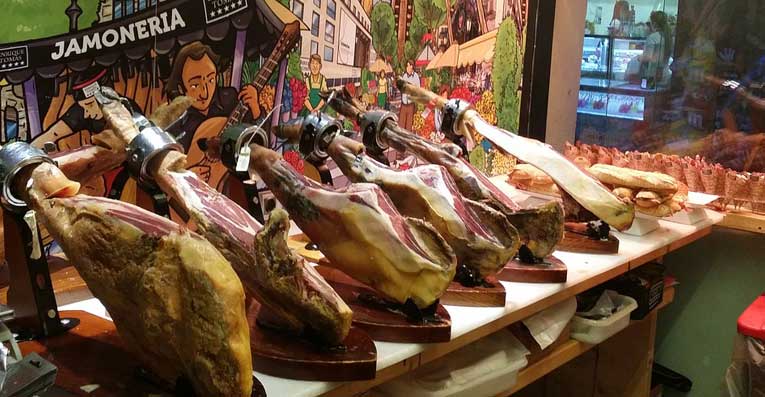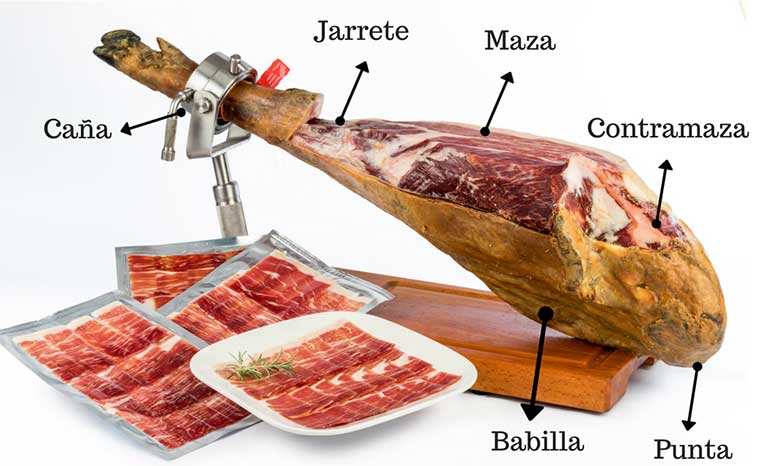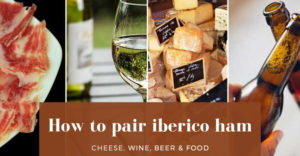What makes Iberico ham special?
Iberico ham is one of these products, which produces a lot of interest where ever it goes. A piece of Spanish culture that goes from country to country, conquering a lot of people with its flavour and texture.
It is difficult today to not find a corner in the world that does not have this appreciated delicacy that mainly is produced in the south of Spain. In this article, I want to share with you everything you have to know when buying, or if you are just curious to know a little more about this piece of the Iberian Peninsula culture
Today we will discuss the following:
– History & Origin of Iberico Ham
– La Dehesa, the paradise where all magic happens
– Benefits of Iberico Ham
– Legislation for the Iberico ham
– Different types of Iberico Ham
– What I´m looking on the Iberico ham labels?
– Production and processing areas
– Nutritional Value of Iberico ham
– The taste and parts of Iberico Ham
– Formats of Iberico Ham
History & Origin of Iberico Ham
From a long time ago, the Iberico pig and the Iberico hams have been a historical heritage for our culture. In the old times eating pork was a signal of power. But also has been satisfying human necessities.
In Spain, the production of pigs and hams dated before the Romans, and we were appreciated by our quality of production. In many places in Spain, pork and ham was a way to pay and exchanged for other goods like wine and oil.
For some historians, it dates back to the CELTICS, where pork became an essential animal for their lives. Nowadays, Iberico ham is presented throughout all Iberian peninsula, from major cities to small towns, you will be able to taste a bit of the Spanish culture. Does not matter if you go to a small tapas bar or a good restaurant.
You will find them hanged on the top of the bar area, and you will have a waitress preparing these delicacies to customer.

The Iberico is a native breed, the pig has a dark colour, sort hair, fine snout, long and thin legs.
Its well knows but its potential to store fat in your muscle tissue, and this is the reason why this is a unique texture and flavour. The finished Iberico hams are recognizable, as are elongated and stylized, black hoff, and varies from pink to purple-red. Bright fat and white to tact.
La Dehesa, the paradise where all magic happens
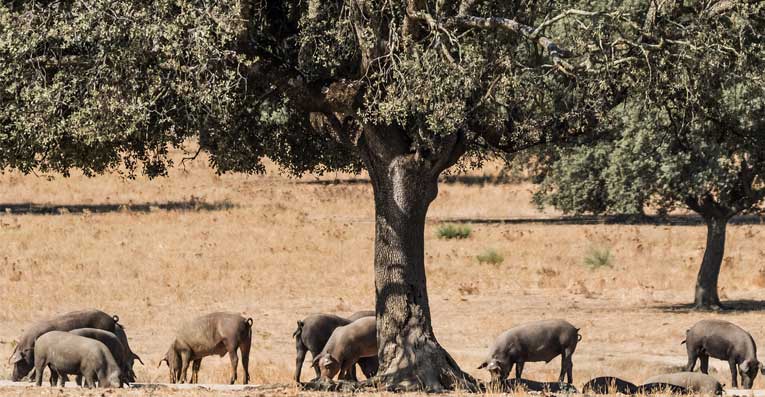
The Dehesa forest, where different trees as the cork oak, holm oak, oak and el “quejido” and other trees like ash. Each tree can give up to 25 kg on acorn per season, think, an hectare will have around 50 trees.
Under all this family of trees, as a result, has the well-known acorn fruit, distinct on each tree, also in this are grows herbs like grass and leguminous.
This is the food than Iberian pigs are delighted, while walks and rest on the big lands of the Dehesa. Also, this animal control any plagues of insect than could affect this environment.
Each pig can eat up to 10 kg of acorn per day and 3 kg of herbs and grass
So think a pig will eat around 800kg of Acorns and 300 to 400 kg of Herbs per Montanera (the season).
What is Montanera? Every year, from October to March, The last phase of the Iberian pig rearing and consists of letting the pig graze in the pasture, where traditional fattening occurs, between forests of cork oaks and holm oaks, being its fruit, the acorn, the fundamental food before slaughter.
Legislation for the Iberico ham
From January 2014, the Spanish Government approved a new regulation about the Iberico Ham, the problem was, than a lot of suppliers was selling hams as Iberico Bellota but those were not. The new regulation applies to the Whole leg of ham, shoulder, and the stick of Iberico cured pork loin.
The regulation helps to differentiate the products depending on the type of food they eat and the purity of the breed.
Different types of Iberico Ham
Iberico ham bellota 100%: it comes from a 100% Iberian breed from mother and father, and has a 100% natural feeding. In winter the pigs eat herbs and flowers, and in summer sometimes can be hungry as is not that much food in the Dehesa. As we say before they eat a lot of acorns between October and March in Montanera. This is the best quality ham you can purchase.
Iberico Ham Bellota 50%: these hams come from a 50% Iberian breed, the female is Iberian and the male comes from a Duroc breed. The feeds are acorns, and natural feed until arrives at 50kg. Those hams are really high-quality hams.
Jamon cebo de campo Iberico: comes from Iberian pigs, but in this case, they feed on extensive Dehesas, they complete their feeding with natural pastures.
Iberico ham cebo: comes from Iberian pigs, fed in extensive regime with pig feed elaborated with cereals and legumes.
What I´m looking on the Iberico ham labels?

After describing the different types of Iberico Ham, i will tell you how they are labelled. All these labels are fitted in the slaughterhouse.
Black label: Iberico ham 100% Iberico.
Red label: Iberico bellota ham.
Green label: jamón de cebo de campo ibérico.
White: iberico cebo ham.
This new regulation helps to preserve the Iberian breed, and the conservation of the productive system developed around the Dehesa.
With all these changes we can offer a better quality of the product and a sustainability in the long term.
Production and processing areas
To ensure the maximum quality of the Iberico Ham is necessary to be an Iberian Breed. The pigs eat acorn in the Dehesa Environment, making them in an artisan-style and air dry naturally, and not controlled temperature.
In Spain are 4 main areas where you will find Iberico ham with its Denominigin of origin: D.O Extremadura, D.O Guijuelo (Salamanca), D.O Sierra of Huelva (where is the famous area of jabugo), and the D.O Pedroches in (cordoba).
Also in Alentejo in Portugal, are big Dehesas, until not long time ago they where bearly abandoned. in 1996, was created a new D.O.P of presunto de Barrancos, for Iberico hams from autochthonous bread, called Alentejano. This breed is considered one of the purest on the Iberian pigs, thanks to the isolation than have been on the last centuries.
The elaboration of Iberian products is particularly extended in all Extremadura, being this region the first production area for Iberico ham. Nearly 1 million hectares of Dehesa than are used for approximately 1500 livestock farms.
The main areas are Badajoz, Ibor y Villuercas, Gredos Sur, Sierra de Montanchez and Sierra de San pedro, in these counties, are allocated the main industries than process Iberico ham.
Benefits of Iberico Ham
The fats of the Iberian pigs feed with acorns, have more than 55% oleic acid. Those fats after shown on scientist research, produce a good effect of cholesterol in the blood. Propitiating an increment of beneficial levels of the good cholesterol (HDL) and reducing the levels of the bad cholesterol (LDL). Only olive oil contains a higher level of oleic acid than the Iberico Ham.
From all animal food, the fat of Iberico hams “cardiosaludable” heart-healthy” are the healthiest fat, being better than other vegetable fats available on the market today.
A part of this benefit to cholesterol, Iberico ham provides good sources of protein, vitamins B1, B6, healthy B12 and folic acid. Beneficial for the nervous system and good function of the brain. Also rich in vitamin E, a good antioxidant, minerals and copper. Essential for the bones and cartilage, calcium, iron, zinc, magnesium, phosphorus and selenium, the latter closely linked to anti-ageing processes.
Nutritional Value of Iberico ham
Per 100 grams or Iberico bellota ham, gives you about 250 kcal, more and less like bread, so if you have a moderate consumption will not harm the hypocaloric diets (low in calories). Is a great substitute of the red meat, because 100g of Iberico ham contains 43 grams of protein.
The only downside of the Iberico ham as the OMS only recommends 5g of salt per day to reduce the risk of suffering cardiovascular disease
The Iberico ham contains the least amount of salt (between 2.5% and 4.5%), following with the serrano ham (5%) and the Bayona ham (5.5%).
The secret is in the genetics of the Iberian breed: the infiltrated fat and a high PH makes the salt difficult to penetrate. If we contrast with other products, will be on the same level as the Roquefort cheese or olives.
The taste and parts of Iberico Ham
The Iberico ham needs to be cut by hand with a sharp knife, ideally at 24ºC. The fat must melt for the knife cut perfectly.
Cutting different parts of the ham you will find different flavours of nuts in the tibia and fibula. A strong aftertaste and itchy throat, at the tip or hip.
Maza: is the main part, the biggest part of the ham, tasty and the most intense flavours. You will find almonds, bright slices, and fat between the muscle tissue.
Contramaza o babilla: is the opposite of the maza, more cured, less fat and thinner. Harmonious and persistent taste with aromas to nuts. We recommend starting cutting the ham on this site as is the dryest part of the ham.
The 3rd cut: Ones we finish to cut the contramaza. To avoid waste any bit of ham, some people create the 3rd cut. This cut will apply with the ham on the site. Is an area with no fat. This cut does not show in the picture.
Codillo: One of the most fibrous parts of every piece of ham is the knuckle, situated between the caña and the maza. Typically to cut in dices, with intense flavour, spicy and juicy
Caña o jarrete: the 4th flavour is situated in this part of the ham, the closest to the hoof. Fibrous meat with intense flavour.
Cadera: At the tip of the ham is the hip. is the part where we can find the most intense and juicy flavour. the meat is at its perfect moment to eat, with the right amount of fat. thanks for its gravity when the Iberico ham is dried, is there where all the flavours and oils concentrate. Tasting shows a strong and itchy aftertaste inside the throat.
The Bones: the bone is a delicacy to make unique stocks than will give a different taste to your favourite dishes. Will need to be cut in smaller pieces of 10 to 12 cm with a shaw, please go to your local butcher to do this.
Other sub-products of Iberico meats called “embutidos”
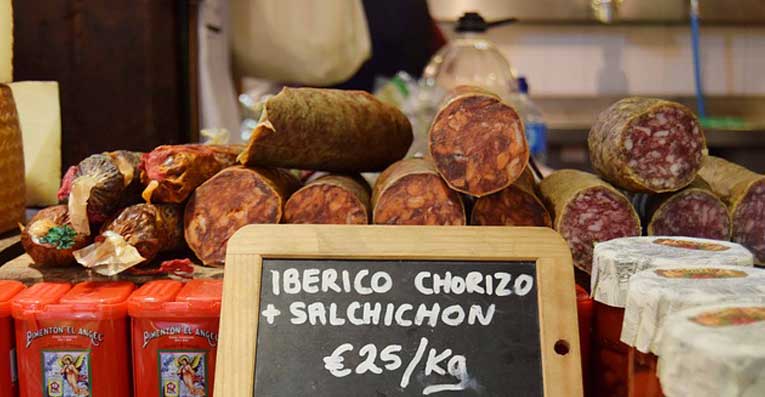
- Iberico Chorizo
- Iberico SAlami
- Morcon Iberico
- Cured Iberico pork Loin
Formats of Iberico Ham
Please refer to this post as we explain all different format you can find in Iberico hams and regular serrano ham. Please visit How Iberico Ham and Serrano ham are presented for consumption.
If you arrived that far, I just need to thank you… We will appreciate if you want to register on our newsletter to receive all new articles and possible offers and sharing with your friends!!! Remember, buying an Iberico ham, you are helping to maintain the Dehesas, a lot of families, and the most important an incredible environment of Spain.
